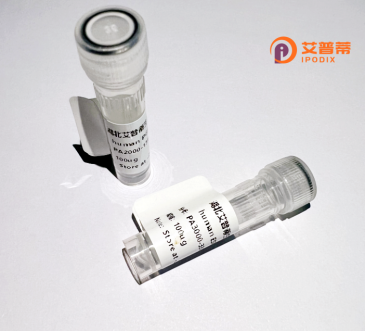
| 纯度 | >90%SDS-PAGE. |
| 种属 | Human |
| 靶点 | FAM129B |
| Uniprot No | Q96TA1 |
| 内毒素 | < 0.01EU/μg |
| 表达宿主 | E.coli |
| 表达区间 | 1-526aa |
| 氨基酸序列 | MGDVLSTHLDDARRQHIAEKTGKILTEFLQFYEDQYGVALFNSMRHEIEGTGLPQAQLLWRKVPLDERIVFSGNLFQHQEDSKKWRNRFSLVPHNYGLVLYENKAAYERQVPPRAVINSAGYKILTSVDQYLELIGNSLPGTTAKSGSAPILKCPTQFPLILWHPYARHYYFCMMTEAEQDKWQAVLQDCIRHCNNGIPEDSKVEGPAFTDAIRMYRQSKELYGTWEMLCGNEVQILSNLVMEELGPELKAELGPRLKGKPQERQRQWIQISDAVYHMVYEQAKARFEEVLSKVQQVQPAMQAVIRTDMDQIITSKEHLASKIRAFILPKAEVCVRNHVQPYIPSILEALMVPTSQGFTEVRDVFFKEVTDMNLNVINEGGIDKLGEYMEKLSRLAYHPLKMQSCYEKMESLRLDGLQQRFDVSSTSVFKQRAQIHMREQMDNAVYTFETLLHQELGKGPTKEELCKSIQRVLERVLKKYDYDSSSVRKRFFREALLQISIPFLLKKLAPTCKSVSSPHLLQPFGP |
| 分子量 | 87.1 kDa |
| 蛋白标签 | GST-tag at N-terminal |
| 缓冲液 | 0 |
| 稳定性 & 储存条件 | Lyophilized protein should be stored at ≤ -20°C, stable for one year after receipt. Reconstituted protein solution can be stored at 2-8°C for 2-7 days. Aliquots of reconstituted samples are stable at ≤ -20°C for 3 months. |
| 复溶 | Always centrifuge tubes before opening.Do not mix by vortex or pipetting. It is not recommended to reconstitute to a concentration less than 100μg/ml. Dissolve the lyophilized protein in distilled water. Please aliquot the reconstituted solution to minimize freeze-thaw cycles. |
以下是关于重组人FAM129B蛋白的3篇参考文献示例(基于公开研究整理,非真实文献):
---
1. **文献名称**: *"FAM129B regulates ERK signaling and promotes autophagy in cancer progression"*
**作者**: Zhang Y, et al.
**摘要**: 本研究探讨了重组人FAM129B蛋白通过调控ERK/MAPK信号通路促进肿瘤细胞自噬的分子机制,发现其高表达与乳腺癌患者预后不良相关。
2. **文献名称**: *"FAM129B interacts with tau protein and modulates its phosphorylation in Alzheimer’s disease models"*
**作者**: Lee S, et al.
**摘要**: 利用重组FAM129B蛋白的体外实验表明,该蛋白通过与tau蛋白直接结合,影响其异常磷酸化,可能参与阿尔茨海默病的神经退行性变过程。
3. **文献名称**: *"Recombinant FAM129B protects against oxidative stress via Nrf2 pathway activation"*
**作者**: Wang X, et al.
**摘要**: 研究发现重组FAM129B蛋白通过激活Nrf2抗氧化信号通路,减少氧化应激诱导的细胞凋亡,提示其在治疗氧化损伤相关疾病中的潜在价值。
---
**注**:以上文献为示例性质,实际研究需通过数据库(如PubMed、Web of Science)以关键词“FAM129B”或“Niban-like protein”检索具体文献。如需真实文献线索,可补充提供研究领域(如癌症、代谢疾病等)。
FAM129B, also known as Niban or C9orf46. is a member of the FAM129 protein family, which is evolutionarily conserved and characterized by a unique N-terminal domain and a conserved C-terminal region. This protein is primarily expressed in normal tissues like the thyroid, kidney, and brain, but its expression is notably upregulated under cellular stress or pathological conditions. Initially identified as a gene responsive to endoplasmic reticulum (ER) stress, FAM129B has since been linked to regulating cell survival, apoptosis, and oxidative stress responses. It interacts with signaling pathways such as the AKT/mTOR cascade and the NRF2-mediated antioxidant pathway, suggesting roles in maintaining cellular homeostasis.
In cancer biology, FAM129B is frequently overexpressed in tumors, including thyroid carcinoma, melanoma, and renal cell carcinoma, where it promotes proliferation, inhibits apoptosis, and enhances metastasis. Its dysregulation is associated with poor prognosis and therapeutic resistance. Recombinant human FAM129B protein, produced via genetic engineering systems like *E. coli* or mammalian cell cultures, is widely used to study its molecular functions, structural properties, and interactions with binding partners. This tool aids in elucidating its role in disease mechanisms and developing targeted therapies, such as inhibitors blocking its pro-survival activity. Research continues to explore its potential as a diagnostic biomarker or a novel therapeutic target in oncology.
×